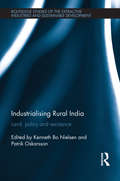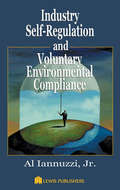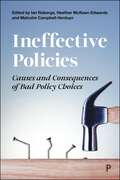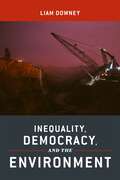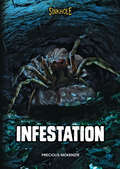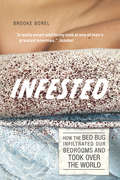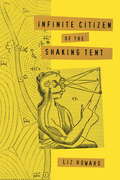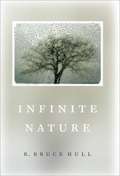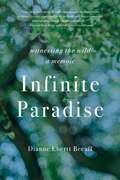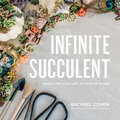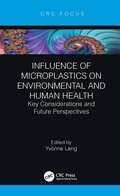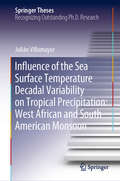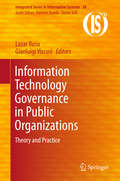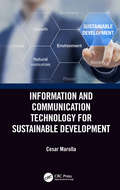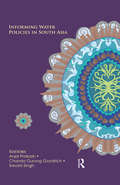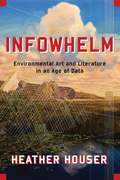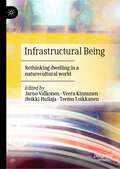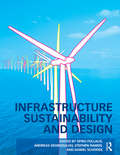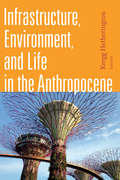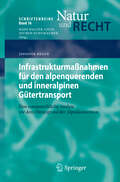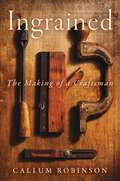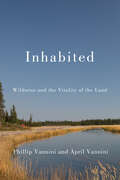- Table View
- List View
Industrialising Rural India: Land, policy and resistance (Routledge Studies of the Extractive Industries and Sustainable Development)
by Kenneth Bo Nielsen Patrik OskarssonRapid industrialisation is promoted by many as the most feasible way of rejuvenating the Indian economy, and as a way of generating employment on a large scale. At the same time, the transfer of land from rural communities and indigenous groups for industrial parks, mining, or Special Economic Zones has emerged as perhaps the most explosive issue in India over the past decade. Industrialising Rural India sheds light on crucial political and social dynamics that unfold today as India seeks to accelerate industrial growth. The volume examines key aspects that are implicated in current processes of industrialisation in rural India, including the evolution of industrial and related policies; the contested role of land transfers, dispossession, and the destruction of the natural resource base more generally; and the popular resistance against industrial projects, extractive industries and Special Economic Zones. Combining the work of scholars long established in their respective fields with the refreshing approach of younger scholars, Industrialising Rural India seeks to chart new ways in the study of contemporary industrialisation and its associated challenges in India. This cutting-edge interdisciplinary work will be of interest to scholars working on industrial development and land questions in India and South Asia alongside those with an interest in sociology , political science and development research.
Industry Genius: Inventions and People Protecting the Climate and Fragile Ozone Layer
by Stephen Andersen Durwood ZaelkeThis book presents the inventive genius behind technological breakthroughs by ten global companies including Alcoa, DaimlerChrysler, Honda, ST Micro and Visteon. Readers will gain understanding and insight into how cutting-edge technology is helping protect the climate and/or the ozone layer, while contributing to the company's bottom line. Each chapter chronicles the challenge and triumph of invention, introduces the engineers and executives who overcome conventional wisdom, and demonstrates the contribution these companies are making to environmental protection. In full colour and crammed with graphics to illustrate the creative process of technological breakthroughs, the book is accessible and informative. The genius of these ten companies will inspire the engineer, the policy-maker, the student, the environmentalist, the CEO and the investor alike.
Industry Self-Regulation and Voluntary Environmental Compliance
by Jr., Al IannuzziWhy self-regulation? With the advent of such concepts as design for the environment, industrial ecology, and the recognized enlightened self-interest that voluntary compliance brings, it is in any company's best interest to avoid fines, liabilities, and bad publicity. Consumer concern and pressure from the marketplace give a competitive advantage t
Ineffective Policies: Causes and Consequences of Bad Policy Choices
by Ian Roberge, Heather McKeen-Edwards, and Malcolm Campbell-VerduynAvailable open access digitally under CC-BY-NC-ND licence. Bad policies have repercussions that can be felt for decades. But what makes a bad policy? And how can it be reversed or improved? Bringing together scholars from Europe and North America, this book goes beyond traditional policy theory to study bad and ineffective policies across three fields: • the environment; • the financial services sector; and • emerging technologies. Using cutting-edge research and analysis, the editors and authors state the case for studying ineffective policies, demonstrate their harmful effects across policy fields and provide policy makers with the tools to reflect, identify, and act upon them.
Inequality, Democracy, and the Environment
by Liam DowneyWinner, American Sociological Association Section on Environment and Technology Allan Schnaiberg Outstanding Publication AwardThe world currently faces several severe social and environmental crises, including economic under-development, widespread poverty and hunger, lack of safe drinking water for one-sixth of the world’s population, deforestation, rapidly increasing levels of pollution and waste, dramatic declines in soil fertility and biodiversity, and global warming. Inequality, Democracy, and the Environment sheds light on the structural causes of these and other social and environmental crises, highlighting in particular the key role that elite-controlled organizations, institutions, and networks play in creating these crises. Liam Downey focuses on four topics—globalization, agriculture, mining, and U.S. energy and military policy—to show how organizational and institutional inequality and elite-controlled organizational networks produce environmental degradation and social harm. He focuses on key institutions like the World Bank, the International Monetary Fund, the U.S. Military and the World Trade Organization to show how specific policies are conceived and enacted in order to further elite goals. Ultimately, Downey lays out a path for environmental social scientists and environmentalists to better understand and help solve the world’s myriad social and environmental crises. Inequality, Democracy and the Environment presents a passionate exposé of the true role inequality, undemocratic institutions and organizational power play in harming people and the environment.
Inferno
by Julian StockwinIn the 17th volume in the popular high-seas nautical adventure series, it is 1807 and Captain Sir Thomas Kydd's famous sea action aboard Tyger has snatched his reputation from ignominy. He is the hero of the hour. But although the British Navy remains imperious, a succession of battles has seen Napoleon victorious on mainland Europe. His enemies have sued for peace and the emperor&’s Continental System, establishing a European blockade, will leave Britain cut off from her economic lifeblood.One small link in this ring of steel is still free of French control: the neutral state of Denmark, which controls the straits through which the entire Baltic trade passes. In an attempt to prevent the French from taking control of Denmark's navy, Kydd's great friend Nicholas Renzi – now the Lord Farndon – is sent on a desperate diplomatic mission to persuade the Danes to give up their fleet to Britain. But the Danes are caught between two implacable forces and will not yield, opting instead for the inferno of battle.
Infestation (Sinkhole)
by Precious McKenzieIt was supposed to be a year to remember for seniors Sofia Schultz and Carmen Hernandez. But when weird things start happening around Foggy Creek, they quickly realize that it will be a memorable year—if they survive! Strange power surges, a missing cat, spooked horses, and mysterious tracks lead the friends to eerie sinkholes. There, they find giant tarantulas that will feed on everything they can get their hairy legs on. Can Sofia and Carmen stop the mutant creatures?
Infested: How the Bed Bug Infiltrated Our Bedrooms and Took Over the World
by Brooke BorelBed bugs. Few words strike such fear in the minds of travelers. In cities around the world, lurking beneath the plush blankets of otherwise pristine-looking hotel beds are tiny bloodthirsty beasts just waiting for weary wanderers to surrender to a vulnerable slumber. Though bed bugs today have infested the globe, the common bed bug is not a new pest at all. Indeed, as Brooke Borel reveals in this unusual history, this most-reviled species may date back over 250,000 years, wreaking havoc on our collective psyche while even inspiring art, literature, and music—in addition to vexatious red welts. In Infested, Borel introduces readers to the biological and cultural histories of these amazingly adaptive insects, and the myriad ways in which humans have responded to them. She travels to meet with scientists who are rearing bed bug colonies—even by feeding them with their own blood (ouch!)—and to the stages of musicals performed in honor of the pests. She explores the history of bed bugs and their apparent disappearance in the 1950s after the introduction of DDT, charting how current infestations have flourished in direct response to human chemical use as well as the ease of global travel. She also introduces us to the economics of bed bug infestations, from hotels to homes to office buildings, and the expansive industry that has arisen to combat them. Hiding during the day in the nooks and seams of mattresses, box springs, bed frames, headboards, dresser tables, wallpaper, or any clutter around a bed, bed bugs are thriving and eager for their next victim. By providing fascinating details on bed bug science and behavior as well as a captivating look into the lives of those devoted to researching or eradicating them, Infested is sure to inspire at least a nibble of respect for these tenacious creatures—while also ensuring that you will peek beneath the sheets with prickly apprehension.
Infinite Citizen of the Shaking Tent
by Liz HowardA stunning debut book of poems from a bold new voice unafraid to engage with the exigencies of our contemporary world. In Liz Howard's wild, scintillating debut, the mechanisms we use to make sense of our worlds - even our direct intimate experiences of it - come under constant scrutiny and a pressure that feels like love. What Howard can accomplish with language strikes us as electric, a kind of alchemy of perception and catastrophe, fidelity and apocalypse. The waters of Northern Ontario shield country are the toxic origin and an image of potential. A subject, a woman, a consumer, a polluter; an erotic force, a confused brilliance, a very necessary form of urgency - all are loosely tethered together and made somehow to resonate with our own devotions and fears; made "to be small and dreaming parallel / to ceremony and decay." Liz Howard is what contemporary poetry needs right now.From the Trade Paperback edition.try, of being formed by a staggeringly wild landscape and then residing in a city, of striving for certainty and exactitude through science and ultimately embracing the expansive potential of poetry.
Infinite Nature
by R. Bruce HullYou would be hard-pressed to find someone who categorically opposes protecting the environment, yet most people would agree that the environmentalist movement has been ineffectual and even misguided. Some argue that its agenda is misplaced, oppressive, and misanthropic—a precursor to intrusive government, regulatory bungles, and economic stagnation. Others point out that its alarmist rhetoric and preservationist solutions are outdated and insufficient to the task of galvanizing support for true reform. In this impassioned and judicious work, R. Bruce Hull argues that environmentalism will never achieve its goals unless it sheds its fundamentalist logic. The movement is too bound up in polarizing ideologies that pit humans against nature, conservation against development, and government regulation against economic growth. Only when we acknowledge the infinite perspectives on how people should relate to nature will we forge solutions that are respectful to both humanity and the environment. Infinite Nature explores some of these myriad perspectives, from the scientific understandings proffered by anthropology, evolution, and ecology, to the promise of environmental responsibility offered by technology and economics, to the designs of nature envisioned in philosophy, law, and religion. Along the way, Hull maintains that the idea of nature is social: in order to reach the common ground where sustainable and thriving communities are possible, we must accept that many natures can and do exist. Incisive, heartfelt, and brimming with practical solutions, Infinite Nature brings a much-needed and refreshing voice to the table of environmental reform.
Infinite Paradise: Witnessing the Wild, a Memoir
by Dianne Ebertt BeeaffExperience a year immersed in the healing power, adventure, and tranquility of the natural world, on sixteen acres of wild land in Southern Ontario, Canada. With personal vignettes and color photographs that track the seasons of a single year, Infinite Paradise connects readers with the wildlife on sixteen acres of forest and water meadow along the Conestoga River in Southern Ontario, Canada. Broken into seasons and then further into months and days, the book focuses on the buoyancy of life, showing readers that in a world battered by global warming, habitat destruction, and species extinction, many riches still remain. Interacting with nature can combat stress, heal the human spirit, and foster new and calming perspectives on life. As Infinite Paradise illustrates, the complexity, beauty, and power of the natural world is available to any reader who stays open to the splendid lifeforms they live among.
Infinite Succulent: Miniature Living Art To Keep Or Share
by Rachael CohenTake your succulents to the next level with these stylish and creative projects From blue- green to purple and pink, flower-shaped to squat and spiky or tall and fuzzy, the variety, versatility, and low-maintenance care of succulents makes them go-to plants for home gardeners. Here, succulent stylist Rachael Cohen shows that these traits also make succulents the ideal material for living art. Tiny, jewel-like succulents can be clipped and replanted in infinite combinations, and unlike cut flowers, they thrive in these arrangements. When planted in corks, they become charming living magnets; when placed in seashells, they are a delightful reminder of a day at the beach. Succulents can also grow nestled in moss, creating an opportunity for even more creativity: arrange them atop mini pumpkins or adorn a headband or a tiny wreath. In addition to illustrated step-by-step instructions for more than a dozen crafts, Cohen explains which succulents are best for each project, how to clip and prepare rosettes and leaves, and what to do when the plants outgrow their art pieces. Lush photographs throughout capture the natural beauty of the plants and boundless range of possible creations.
Influence of Microplastics on Environmental and Human Health: Key Considerations and Future Perspectives
by Yvonne LangMicroplastics have received increased attention in the research world over the last ten years. A number of significant publications by the World Health Organisation, European Union, SAPEA, and GESAMP have highlighted this growing environmental and health emergency. This book provides an accessible introduction to the microplastic problem and details its potential impact both on nature and human health. Filled with the latest developments in the field, it attempts to address the gaps in our knowledge of microplastics and will also propose additional areas of research and impact to be considered to resolve this crisis. It will be of interest to researchers and academics working in the areas of microplastic pollution, microplastic detection, and the impact of microplastics on environmental and human health. It will also be of use to undergraduate students of environmental programmes, analytical programmes, and public health programmes. Key Features: Chapters describe the impact of our reliance on plastics in certain sectors and how they relate to microplastic pollution Investigates emerging solutions to the microplastic pollution Presents a multi-disciplinary perspective, covering topics such as analytical techniques, quantitative techniques, environmental monitoring, and human health monitoring
Influence of the Sea Surface Temperature Decadal Variability on Tropical Precipitation: West African and South American Monsoon (Springer Theses)
by Julián VillamayorIn this book the Sea Surface Temperature (SST) patterns of decadal-to-multidecadal variability observed and simulated by 17 general circulation models (GCMs) are analyzed. Furthermore, their impact on precipitation in West Africa and South America and the atmospheric mechanisms involved are assessed. Through this analysis, the effect of external forcings on these impacts and the relative contribution of decadal-to-multidecadal variability patterns of SST to precipitation are presented in depth. Finally, a humid period in the West African region of the Sahel during the 19th century, previously little documented, is analyzed using an atmospheric GCM.The monsoons of West Africa and South America have shown changes in the timescales of a few decades. Previous work suggests a relationship with patterns of decadal-to-multidecadal variability of SST, such as global warming and the Atlantic and Pacific variability. However, the dynamics underlying this relationship and its simulation by current GCMs had not been addressed in a consistent manner. This is the main motivation of this book. The results of this book not only represent a great step forward in our understanding of the changes in the precipitation regimes of the studied regions, but they can also be of great help for the improvement of decadal prediction systems and the associated social consequences.
Information Technology Governance in Public Organizations
by Gianluigi Viscusi Lazar RusuThis book examines trends and challenges in research on IT governance in public organizations, reporting innovative research and new insights in the theories, models and practices within the area. As we noticed, IT governance plays an important role in generating value from organization's IT investments. However there are different challenges for researchers in studying IT governance in public organizations due to the differences between political, administrative, and practices in these organizations. The first section of the book looks at Management issues, including an introduction to IT governance in public organizations; a systematic review of IT alignment research in public organizations; the role of middle managers in aligning strategy and IT in public service organizations; and an analysis of alignment and governance with regard to IT-related policy decisions. The second section examines Modelling, including a consideration of the challenges faced by public administration; a discussion of a framework for IT governance implementation suitable to improve alignment and communication between stakeholders of IT services; the design and implementation of IT architecture; and the adoption of enterprise architecture in public organizations. Finally, section three presents Case Studies, including IT governance in the context of e-government strategy implementation in the Caribbean; the relationship of IT organizational structure and IT governance performance in the IT department of a public research and education organization in a developing country; the relationship between organizational ambidexterity and IT governance through a study of the Swedish Tax Authorities; and the role of institutional logics in IT project activities and interactions in a large Swedish hospital.
Information and Communication Technology for Sustainable Development
by Cesar MarollaInformation and Communication Technology for Sustainable Development shows how ICT, as an enabler for all spheres of development, can help innovate business processes and operations, and provide faster integration of new technologies into business systems. Focused on sustainability, the book addresses strategic approaches to cope with a range of climatic, environmental, cyber-security threats and other global risks, and aims to promote prosperity and economic growth. Furthermore, it explores how the adoption of new technologies, and collective action based upon a strategic behavioral theory of new leadership, can be applied when responding to specific set of conditions that allow for the proposed strategies to cope with risks. Information technology and strategic planning complement each other to attain the sustainable development goals (SDGs). Risk management frameworks, business continuity systems, and strategic planning methodologies such as mechanism design theory, strategic adaptive cognition (SAC), and risk mechanism theory (RMT) are the fundamental components needed to have a universal approach embedded into the national development plans agenda. As technology no longer follows an orderly, linear path, but improves exponentially, developing a strategic approach to ICT implementation help world leaders in the difficult but inspiring task of making a sustainable world and consequently find solutions to achieve the SDGs and the desired growth pattern that must be sustained, inclusive and equitable. Features: Discusses for the first time the potential of ICT as a transformative power in finding solutions to climatic and economic issues. Illustrates comprehensive strategic planning for leaders to implement in both public and private organizations. Integrates standards and frameworks in the context of sustainable development along with the UN Sustainable Development Goals. Describes in detail how mechanism design, risk management, business continuity systems, a comprehensive strategic planning using SAC (Strategic Adaptive Cognition) and risk mechanism theory can be used to address environmental risks and attain sustainable development goals (SDGs). Explains eHealth as an adaptation strategy to address future changes in climate and impacts, and the links between mitigation and adaptation to ICTs.
Informing Decisions in a Changing Climate
Everyone--government agencies, private organizations, and individuals--is facing a changing climate: an environment in which it is no longer prudent to follow routines based on past climatic averages. State and local agencies in particular, as well as the federal government, need to consider what they will have to do differently if the 100-year flood arrives every decade or so, if the protected areas for threatened species are no longer habitable, or if a region can expect more frequent and more severe wildfires, hurricanes, droughts, water shortages, or other extreme environmental events. Both conceptually and practically, people and organizations will have to adjust what may be life-long assumptions to meet the potential consequences of climate change. How and where should bridges be built? What zoning rules may need to be changed? How can targets for reduced carbon emissions be met? These and myriad other questions will need to be answered in the coming years and decades. Informing Decisions in a Changing Climate examines the growing need for climate-related decision support--that is, organized efforts to produce, disseminate, and facilitate the use of data and information in order to improve the quality and efficacy of climate-related decisions. Drawing on evidence from past efforts to organize science for improved decision making, it develops guidance for government agencies and other institutions that will provide or use information for coping with climate change. This volume provides critical analysis of interest to agencies at every level, as well as private organizations that will have to cope with the world's changing climate.
Informing Water Policies in South Asia
by Anjal Prakash Chanda Gurung Goodrich Sreoshi SinghThis book analyzes water policies in South Asia from the perspective of Integrated Water Resources Management (IWRM). It seeks to address the problems of water scarcity, conflict and pollution resulting from the gross mismanagement and over-exploitation of this finite resource. Highlighting the need for IWRM in mitigating abuse and ensuring sustainable use, it discusses issues relating to groundwater management; inter-state water conflicts; peri-urban water use; local traditional water management practices; coordination between water users and uses; and water integration at the grassroots level. With case studies from India, Bangladesh, Pakistan, and Nepal, the innovative, painstaking and transnational researches presented in the volume deal with questions of equity, gender, sustainability, and democratic governance in water policy interventions. It will interest researchers and students of development studies, environmental studies, natural resource management, water governance, and public administration, as also water sector professionals, policymakers, civil society activists and governmental and nongovernmental organizations.
Infowhelm: Environmental Art and Literature in an Age of Data (Literature Now Ser.)
by Heather HouserHow do artists and writers engage with environmental knowledge in the face of overwhelming information about catastrophe? What kinds of knowledge do the arts produce when addressing climate change, extinction, and other environmental emergencies? What happens to scientific data when it becomes art? In Infowhelm, Heather Houser explores the ways contemporary art manages environmental knowledge in an age of climate crisis and information overload.Houser argues that the infowhelm—a state of abundant yet contested scientific information—is an unexpectedly resonant resource for environmental artists seeking to go beyond communicating stories about crises. Infowhelm analyzes how artists transform the techniques of the sciences into aesthetic material, repurposing data on everything from butterfly migration to oil spills and experimenting with data collection, classification, and remote sensing. Houser traces how artists ranging from novelist Barbara Kingsolver to digital memorialist Maya Lin rework knowledge traditions native to the sciences, entangling data with embodiment, quantification with speculation, precision with ambiguity, and observation with feeling. Their works provide new ways of understanding environmental change while also questioning traditional distinctions between types of knowledge. Bridging the environmental humanities, digital media studies, and science and technology studies, this timely book reveals the importance of artistic medium and form to understanding environmental issues and challenges our assumptions about how people arrive at and respond to environmental knowledge.
Infrastructural Being: Rethinking dwelling in a naturecultural world
by Jarno Valkonen Veera Kinnunen Heikki Huilaja Teemu LoikkanenThis book provides a comprehensive insight into the contemporary naturecultural world by exploring infrastructures through the dwelling approach. The notion of naturecultures has been utilized in environmental humanities and social sciences to emphasize the inherent messiness of the lived world and the inseparability of social and biophysical elements. Concept of naturecultures stresses that seemingly “natural” is always simultaneously “cultural” and vice versa. This approach allows fleshing out the messy engagements with infrastructures, which in this book is conceptualized as infrastructural being. This book is a contribution to emerging discussions on infrastructures in the fields of environmental social sciences and humanities. It sensitizes to the peculiarities of modern dwelling and modern, yet often overlooked, ways of being connected with nature. Moreover, it provides tools for speculating, how could things be otherwise. The book is a topical response to the urgent call for developing new forms of human-nature relations in times of environmental turbulence.
Infrastructure Sustainability and Design
by Andreas Georgoulias Daniel Schodek Spiro Pollalis Stephen RamosYou're overseeing a large-scale project, but you're not an engineering or construction specialist, and so you need an overview of the related sustainability concerns and processes. To introduce you to the main issues, experts from the fields of engineering, planning, public health, environmental design, architecture, and landscape architecture review current sustainable large-scale projects, the roles team members hold, and design approaches, including alternative development and financing structures. They also discuss the challenges and opportunities of sustainability within infrastructural systems, such as those for energy, water, and waste, so that you know what's possible. And best of all, they present here for the first time the Zofnass Environmental Evaluation Methodology guidelines, which will help you and your team improve infrastructure design, engineering, and construction.
Infrastructure, Environment, and Life in the Anthropocene (Experimental Futures)
by Kregg HetheringtonInfrastructure, Environment, and Life in the Anthropocene explores life in the age of climate change through a series of infrastructural puzzles—sites at which it has become impossible to disentangle the natural from the built environment. With topics ranging from breakwaters built of oysters, underground rivers made by leaky pipes, and architecture gone weedy to neighborhoods partially submerged by rising tides, the contributors explore situations that destabilize the concepts we once relied on to address environmental challenges. They take up the challenge that the Anthropocene poses both to life on the planet and to our social-scientific understanding of it by showing how past conceptions of environment and progress have become unmoored and what this means for how we imagine the future. Contributors. Nikhil Anand, Andrea Ballestero, Bruce Braun, Ashley Carse, Gastón R. Gordillo, Kregg Hetherington, Casper Bruun Jensen, Joseph Masco, Shaylih Muehlmann, Natasha Myers, Stephanie Wakefield, Austin Zeiderman
Infrastrukturmaßnahmen für den alpenquerenden und inneralpinen Gütertransport: Eine europarechtliche Analyse vor dem Hintergrund der Alpenkonvention
by Jennifer HeuckDas steigende Güterverkehrsaufkommen in der Europäischen Union führt zu Umweltbeeinträchtigungen, von denen der Alpenraum in besonderem Maße betroffen ist. Das vorliegende Werk geht der Frage nach, wie dem unter Berücksichtigung der Grundfreiheiten der Europäischen Union - insbesondere des freien Warenverkehrs - durch gezielte rechtliche Maßnahmen begegnet werden kann. Zentrale Bedeutung kommt dabei den rechtlichen Bestimmungen zur Errichtung und Nutzung von Infrastrukturen für den alpenquerenden und inneralpinen Güterverkehr zu, insbesondere der Alpenkonvention - einem völkerrechtlichen Abkommen zum Schutz und Erhalt der Alpen - und ihrem Verkehrsprotokoll, deren Vertrags- bzw. Unterzeichnerparteien die Europäische Union sowie die acht Alpenstaaten sind. Die Alpenkonvention und das Verkehrsprotokoll werden in dem Werk erstmals umfassend dargestellt und analysiert. Schließlich zeigt die Untersuchung, welche rechtlichen Wirkungen das Verkehrsprotokoll, das die Europäische Union bisher lediglich unterzeichnet hat, im Falle seiner Ratifikation für die Europäische Union entfalten würde.
Ingrained: The Making of a Craftsman
by Callum RobinsonLONGLISTED FOR THE 2025 ANDREW CARNEGIE MEDAL FOR EXCELLENCE IN NONFICTIONFor fans of H Is for Hawk and Shop Class as Soulcraft comes a captivating literary memoir, immersing readers in the life of a Scottish carpenter as he perfects his craft, builds a business, and reflects on what inheritance and shared responsibility really mean.The eldest son of a master woodworker, Callum Robinson spent his childhood surrounded by wood and trees, absorbing craft lessons in his father’s workshop. In time he became his father’s apprentice, helping to create exquisite bespoke objects. But eventually the need to find his own path led him to establish his own workshop and chase ever bigger and more commercial projects, until the devastating loss of one major job threatened to bring it all crashing down. Faced with the end of his business, his team, and everything he had worked so hard to build, he was forced to question what mattered most. In beautifully wrought prose, Callum tells the story of returning to the workshop and to the wood, to handcrafting furniture for people who will love it and then pass it on to the next generation—an antidote to a culture where everything seems so easily disposable. As he does so, he brings us closer to nature and the physical act of creation—and we begin to understand how he has been shaped, as both a craftsman and a son. Blending memoir and nature writing at its finest, Ingrained is an uplifting meditation on the challenges of working with your hands in our modern age, on community, consumerism, and the beauty of the natural world—one that asks us to see our local trees, and our own wooden objects, in a new and revelatory light.
Inhabited: Wildness and the Vitality of the Land
by Phillip Vannini April VanniniPeople are key elements of wild places. At the same time, human entanglements with wild ecologies involve extractivism, the growth of resource-based economies, and imperial-colonial expansion, activities that are wreaking havoc on our planet.Through an ethnographic exploration of Canada’s ten UNESCO Natural World Heritage sites, Inhabited reflects on the meanings of wildness, wilderness, and natural heritage. As we are introduced to local inhabitants and their perspectives, Phillip Vannini and April Vannini ask us to reflect on the colonial and dualist assumptions behind the received meaning of wild, challenging us to reimagine wildness as relational and rooted in vitality. Over the three years they spent in and around these sites, they learned from Indigenous and non-Indigenous peoples about their entanglements with each other and with non-human animals, rocks, plants, trees, sky, water, and spirits. The stories, actions, and experiences they encountered challenge conventional narratives of wild places as uninhabited by people and disconnected from culture and society. While it might be tempting to dismiss the idea of wildness as outdated in the Anthropocene era, Inhabited suggests that rethinking wildness offers a better – if messier – way forward.Part geography and anthropology, part environmental and cultural studies, and part politics and ecology, Inhabited balances a genuine love of nature’s vitality with a culturally responsible understanding of its interconnectedness with more-than-human ways of life.
